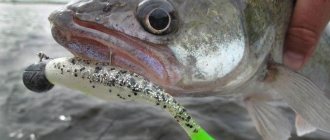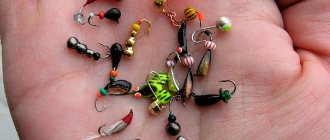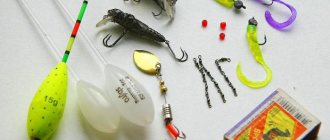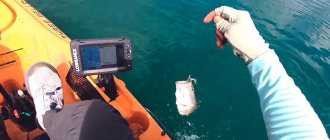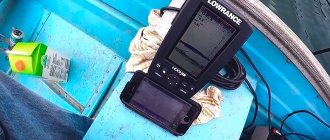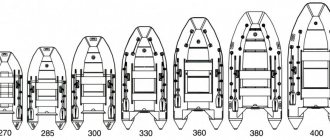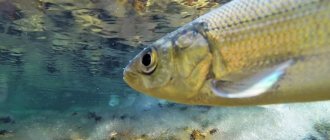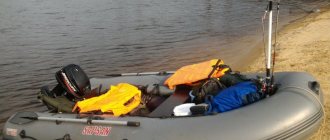What is an echo sounder
Thanks to technological progress, in our time a lot of new technology is constantly appearing, and this leads to the emergence of new innovations in various spheres of life. This time, technological progress has reached fishing - an echo sounder has appeared in the arena of popular and useful devices. The first such devices were used during the First World War, but it took a long time for compact devices accessible to ordinary citizens to appear.
Why do you need an echo sounder when fishing? To understand this, let's understand its structure and capabilities based on its operating principle.
So, the device consists of several main modules:
- transmitter;
- signal converter;
- receiver;
- display.
The principle of operation of an echo sounder is quite simple: an electrical impulse from the transmitter is converted into a sound wave, directed into the water column, using a transducer.
The light, having reached an object, is reflected and enters the transducer (echo effect), which turns it back into an electrical signal. The return electrical signal is amplified by the receiver and displayed on the display. It becomes clear that the capabilities of the echo sounder allow you to visually “probe” the bottom for its curvature and recesses in which fish like to hide, determine the presence of snags and other objects, and, of course, see the accumulation of fish.
Echo sounder: why is it needed?
This question interests many fishermen who catch fish the old fashioned way. In general, this is akin to the question of the benefits of computer technology in various areas of our lives. Fishing with an echo sounder is not only an opportunity to determine the exact location of both a single fish and a school of fish of any size. Using an echo sounder, you can see the topography of any bottom, and by comparing your knowledge with the resulting image, draw a conclusion about whether there are fish in a particular place. A temperature sensor and an atmospheric pressure sensor will help clarify these conclusions - an experienced fisherman knows what parameters each type of fish prefers and how this data affects its behavior. Analysis of the day's relief allows you to timely notice underwater shallows and the remains of trees and piles of stones that do not protrude above the surface of the water and avoid troubles - damage to your boat.
For fishing professionals
Does a skilled fisherman need an echo sounder? Skillful tuning of the sonar makes fishing not only successful, but also very interesting. As a rule, all echo sounders have standard settings that are automatically activated when turned on. By adjusting them to suit you, you can see an accurate picture of the underwater situation and all objects under the boat, including the size of the fish itself - after all, it is known that many anglers dream of catching a large specimen of pike or other fish. It is also important that the echo sounder can scan the bottom topography, which is extremely important for any fishing, since the largest fish are often found in the holes. Knowing the favorite habitats of fish, you can easily find them by analyzing the scanner data. And such an opportunity as a visual display of underwater accumulations of snags and stones allows you to save expensive gear.
The use of echo sounders is relevant at any time of the year. Experts say that they are useful both in winter and summer. A thick layer of ice on bodies of water does not allow for a wide search, and the liquid crystal screen freezes at temperatures below 15 degrees Celsius. Therefore, it is recommended to attach the echo sounder under your jacket using a special belt. However, there are also models specifically designed for each season, including winter fishing. These include the Practitioner ER-6 Pro 2 Premium echo sounder, which can be used effectively at lower temperatures.
Technique for using an echo sounder when fishing
In order for the selected echo sounder for fishing from a boat to bring maximum benefit, it should be configured “to suit you.”
- When you turn on the device, all the necessary settings automatically appear on the screen, optimally suited for searching for a fishing spot and studying the bottom topography. But on some echo sounders, depth measurement parameters are indicated in feet, which is not always convenient for understanding. You can manually adjust this deficiency through the menu.
- For shallow depths, it is recommended to set the radiation frequency to 192 hertz, and the scanning angle of the area to 20-24 degrees.
- In order for the picture on the display to be of the highest possible quality, the speed of the boat should not be too fast, preferably moderate if possible.
- Objects located under the boat are displayed in the right corner of the monitor. The bottom surface is displayed at the bottom of the screen.
- More expensive models of echo sounders for fishing from a boat are able to determine the exact locations of fish concentrations, while simple devices cannot clearly distinguish prey from other types of underwater objects.
- You should know that the larger the prey, the clearer the symbol on the monitor.
- The process of attaching the echo sounder must occur in accordance with the rules for installing the device on a boat. Otherwise, when the boat moves, you can not only damage the device, but also completely lose it.
A little about the additional functions of echo sounders
The effectiveness of fishing using inexpensive models of echo sounders can be significantly higher if they are equipped with additional sensors. Often the standard sensors included in the kit are not entirely suitable for the specific conditions of some water areas. You can improve the image quality and increase the information content of the device without purchasing a new echo sounder if you purchase additional sensors.
The catalog of our online store contains a wide selection of additional sensors for sonars with 3D technology and conventional echo sounders. Among the wireless models and devices with a cable, you can choose both models in the form of a floating float, and devices for installation directly on the watercraft. The range includes single- and double-beam sensors, expanding the capabilities of the echo sounder, and multi-beam (from 4 to 6 beams), capable of exploring a large bottom area. For some inexpensive models, you can purchase an additional speed sensor and a water temperature sensor, which determines the success of fishing.
Source: KotoFoto.ru
Methods for attaching echo sounders
Today, manufacturers of fishing products produce echo sounders for fishing from a boat not only with a plastic, but also with a metal body.
To reliably and efficiently install the device on a swimming craft, use the following mounting methods:
- Epoxy glue is used to attach the echo sounder to a boat made of polymer materials. The device is placed on the inside of the craft. You should be aware that with this method of mounting, picture distortions and inaccuracies in determining depth may occur.
- To mount the device on a slow-moving boat, a transom mounting method is used: the bracket is installed slightly below the water level. Thanks to the mobility of the entire structure, the fixed transmitter is protected from hard collisions with all kinds of obstacles. Here we can note the reliability of fastening and ease of use. On high-speed boats, minor errors in the operation of the echo sounder may be observed due to the boat's propellers.
- Through fastening as the most effective fastening method is especially popular. Through a special hole in the boat, which you make yourself, the sensor is securely fixed. The signal has great power, and the device itself lasts for decades.
Purpose of the echo sounder
An echo sounder allows you to constantly monitor the thickness of the water under the vessel, thereby tracking changes in the bottom topography. Constant monitoring (sending and receiving pulses reflected from objects and the bottom) helps fishing professionals and amateurs detect targets - fish - from the image displayed on the screen. At the same time, an experienced echo sounder user can find fish by indirect signs, and not just by a clear image of the fish on the echo sounder screen.
Equipped with built-in GPS ( Humminbird HELIX 5 SONAR ) provides the ability to use electronic maps for navigation and save data on the location of objects found in the water column with a high degree of accuracy. This device is a chartplotter-echo sounder and combines the capabilities of both devices. In order to buy a suitable echo sounder, you need to learn more about its structure and purpose.
Main characteristics
Like any other electronic device, echo sounders have a set of basic characteristics that are a dictating factor when choosing it.
- The first and practically the most important parameter of any sonar is the transmitter power. The higher it is, the more efficiently and correctly the device can record objects at depth.
- You should definitely pay attention to the screen resolution. The clarity of the displayed information directly depends on the power and configuration of the display. Even if you fish at relatively shallow depths, it is better to choose models with a power of at least 500-600 watts. The screen can be either black and white or color depending on the model. Lately, expensive 3D echo sounders have become very popular.
Additional features typically include:
- “zoom” by analogy with a camera - a close-up view of the bottom (detailed review);
- “alarm” is a sound alarm that reports various changes, from entering shallow water to detecting fish of the required size;
- “grayline” function allows you to distinguish living objects from various natural ones;
- “fishtrack” - the ability to track the movement of fish within the operation of the echo sounder;
- "fish-ID" identifies fish on the screen with a clear symbol. Cheaper models show it in an arc.
How does an echo sounder work?
Pulse sending frequency
The echo sounder sends pulses at a certain frequency. Typically, manufacturers of devices of this type use the following frequencies: 192/200 kHz, 50 kHz, 83 kHz, 455 kHz and 800 kHz. All designated pulse sending frequencies by the echo sounder sensor have both advantages and disadvantages. Therefore, when choosing a device, you must take into account the specific conditions in which you plan to use the echo sounder.
The first, second and third of the listed frequencies are used most often. Their difference is as follows:
| 192 or 200 kHz | 50 kHz | 83 kHz |
|
|
|
Two relatively new frequencies are 455 kHz and 800 kHz. The first operates at a greater depth than 800 kHz. However, the second is distinguished by a higher quality of drawing details of the bottom structure. 800 kHz is best used in depths of 18 meters or less, although at high speed it is also suitable for exploring deeper waters: since more pulses are sent, the image will be more detailed than with transducers with other frequencies. You can find devices in Lowrance line of fish , suitable for solving almost any problem.
Operating principles of an echo sounder
The pulse sent by the echo sounder sensor is reflected from various objects that it encounters on its way, or the bottom. This allows you to collect information about everything that is in the water column: the number, size, density of objects, and the structure of the bottom. The display processor processes the received information, resulting in a moving graphic image being displayed on the screen. Because signals are sent and received many times per second, a continuous line is drawn on the screen to indicate the bottom. Garmin , Raymarine , Hummingbird echo sounders are almost always equipped with either color or monochrome displays of various sizes
Choosing an echo sounder for effective fishing from a boat
When planning to purchase a specific model of echo sounder for fishing from a boat, it is recommended to study its main parameters:
- Screen. Each echo sounder model has its own specific resolution: the higher this indicator, the clearer the picture on the monitor. If it is lower, the characters on the display will be distorted and it will be more difficult to understand the information received. Given the increased interest in such devices among the fishing community, echo sounder manufacturers are constantly searching for new solutions to improve the level of comfort and functionality of their sonars; devices with a large monitor that provide information in 3D format have already been developed and are being produced. The positive qualities of such modernized echo sounders include: accurate identification of prey habitats and other underwater objects, increasing the chances of catching a trophy specimen.
- Sensors Echo sounders can be equipped with various sensors depending on the model: water temperature sensor, current speed sensor, side devices designed to correctly determine the side where the prey lives. For novice fishermen, it will be enough to purchase an echo sounder with one sensor; once they acquire the appropriate skills, they will be able to think about a more functional device.
- Number of rays. The most convenient option is a single-beam echo sounder with a medium viewing angle. As for devices with several beams that are capable of scanning a wide area, there is a drawback here - dead zones with insufficient visibility of the fished object.
- Signal frequency. The most common fishing devices are those with a frequency of 200 kHz, but echo sounders with a frequency of 50 kHz do not go unnoticed. Undoubtedly, devices with a frequency of 200 kHz are distinguished by the clearest picture, where two fish located nearby will be identified by the device as two independent icons, and not as one whole. But it also has its drawbacks: image clarity is lost when the craft moves at high speed. These devices work great in shallow waters.
- Transmitter power. It is this indicator that should be the determining criterion in choosing a specific echo sounder model, taking into account the direct dependence of the quality of the received signal on the power parameter. A more powerful device is able to provide the most accurate picture of everything that happens under water. This indicator is especially important when fishing in reservoirs with great depth and muddy water.
- Price. Of course, most consumers focus on price when choosing a device for fishing from a boat. But, based on practice, budget models with a single-beam or double-beam probe can quite adequately cope with everyday fishing tasks.
Components of an echo sounder
The echo sounder consists of two parts - a transducer (sensor) and a display. However, there are many models of echolocation sensors on the market without a monitor, since many modern models of multifunction displays ( MFDs ) support the display of data received from the transducer. .
The emitter sensor is installed on the bottom of the vessel below the waterline and is directed to the bottom. The sensor sends signals towards the bottom and receives them after reflection from the bottom or other objects encountered along its path. Data from the sensor is processed and displayed on a special display - included in the delivery kit or any other compatible with the transducer used.
Source: seacomm.ru
Classic echo sounder (sonar)
Pulses sent by the echo sounder can be of different frequencies - 60 Hz , 83 Hz , 200 Hz , etc. In water, a sound wave is most easily described as a cone that has a certain angle. The picture clearly shows the dependence - the higher the frequency, the narrower the “beam”. Without delving into complex mathematical models, the angler should understand two simple things. A beam with a higher frequency provides a more detailed image of the surface and objects in the water column, but at the same time captures a smaller area. Low-frequency beams, on the other hand, have a wide coverage but produce less detail. It is also worth considering one more property - the lower the frequency of the signal, the deeper it can penetrate into the water column.
Echo sounders (sonars) come in single-beam and double-beam types. The simplest ones are single-beam echo sounders. When choosing such an echo sounder, you should decide on the goals and tasks that the device will perform. If accurate and detailed information about the structure of the bottom is important to you, then you should pay attention to echo sounders with a narrow and high-frequency beam. If the purpose of the echo sounder is to detect fish under the boat, then it is better to give preference to devices with a wider beam and low frequency.
Much more convenient, but also more expensive, are double-beam echo sounders. Such sonars have two beams with different frequencies and on the screen you can see the result of their combined action - a clear bottom and a wide range of objects in the water column.
At the moment, almost all echo sounders are equipped with an intelligent fish recognition function. Despite the fact that algorithms are constantly being improved, you should not trust this information one hundred percent. Very often, devices mistake thin tree branches, floating debris, etc. for fish.
Separately, it is worth mentioning sonars with Chirp . The principle of its operation is to send pulses in batches, which allows for much better and more accurate identification of objects from the general noise. The picture on such devices is more detailed and with less noise.
Scanning echo sounders
Echo sounders with a bottom scanning function have appeared on the fishing market relatively recently. The principle of their operation is somewhat different from classic sonar. The sensor of such an echo sounder contains a special piezoelectric element, which acts as an emitter and receiver. It is capable of sending a large number of high-frequency pulses, as if scanning the water space. Those. Instead of one beam, as in a classic sonar, the same area is penetrated by several narrower ones. As a result, we get a super detailed image of everything that happens under water. It is often possible to see not just a tree lying at the bottom, but also small fish standing under it or in its branches.
Here, as in classic echo sounders, there are two main frequencies: 455 kHz and 800 kHz . The general principle is the same - the higher the frequency of the beam, the more detailed image we will get, and the lower, the more space we will capture.
The next stage of development was echo sounders with a side scanning function. In the sensors of such echo sounders, the rays are directed not only down under the boat, but also on opposite sides of it. This made it possible to scan the bottom to the left and right of the boat for tens of meters. And the use of side rays together with the bottom one gives the most complete picture.
One point is worth noting here. The point is that you need to understand the main difference in the operating principles of a classic sonar and a scanner. If you imagine the projection of a sonar beam on the bottom, it will be a circle, the diameter of which depends on the angle and depth. The projection of the rays of the scanning echo sounder is a narrow strip. Those. In order to cover the same area, a boat with a scanning echo sounder will have to move. The analogy of a scanner beam scanning the surface of a sheet works well here.
So. How to choose an echo sounder from all this variety? Which echo sounder is better?
The simplest and most inexpensive solution would be hand-held single-beam echo sounders. Despite the fact that most of them are positioned as “winter”, no one will forbid you to use them in the summer. You just have to figure out how to attach the sensor to your boat. You will get an inexpensive and universal solution.
If you are willing to spend a slightly larger amount and are not interested in using the device in winter, then you should opt for two-beam echo sounders. When choosing, pay attention to the angles and frequencies of the rays. If you need an echo sounder, for example, to catch bream, then give preference to the device where the beams have the maximum width - this is more convenient when searching for schooling fish. If you fish with a jig or wobblers along the terrain, then choose an echo sounder with narrower and high-frequency beams - such a device will show the details of bottom anomalies much better.
An important point when choosing an echo sounder is the quality of the screen. Here, high resolution and number of shades are preferable. Both of these parameters directly affect the information content and quality factor of the signal display.
You should not lose sight of the mechanical part - the type of fastening and the ability to rotate the head of the device. Often, in cramped conditions of small boats, this parameter can come to the fore.
Those who are serious about spin fishing on large reservoirs should choose a fish finder with scanning technology. The price for them is noticeably higher, but the quality of rendering the relief, small details on the bottom, as well as objects in the water column is at a completely different level. What to pay attention to here?
The simplest and relatively inexpensive option would be an echo sounder with a bottom scanning function, a beam frequency of 455 kHz and a small black and white screen. The absence of a second beam with a frequency of 800 kHz is not as scary as it might seem at first glance. The fact is that in the vast majority of cases, a low-frequency beam is used to search for bottom anomalies. Its quality factor is more than enough to draw a good picture, and the wide coverage of the scanned space will facilitate the search and save a lot of time.
The value of the screen diagonal and its resolution in echo sounders of this type is noticeably higher, so we choose a device with the highest possible performance. Again, a color image is more informative. If you can afford it, we give preference to it.
A separate class are devices equipped with two additional beams designed for side scanning. The amount of information received from such an echo sounder is truly enormous, and the time spent on exploring and understanding a new water area is reduced significantly. Without a doubt, this is the best choice possible. But the price of such devices is already far from budget.
Hybrid echo sounders . Today, many models include both classic sonar and scanning functions. This solution is very versatile and allows you to take advantage of the benefits of each technology in one device.
Echo sounders-chart plotters . Navigating in deep water without a GPS navigator is very difficult. In order not to take several devices with you into the boat, manufacturers have built in a chartplotter function into the echo sounder. This is very convenient - you can save catchy points or tracks, navigate on the map without looking up from the main device.
Wireless echo sounders
Progress does not stand still and now echo sounders are available to those who fish from the shore. Such devices are a small-diameter ball with a built-in echo sounder sensor and Bluetooth or Wi-Fi . It is enough to install special software on your smartphone or tablet, and it will turn into a full-fledged echo sounder. Next, using a rod of the appropriate test, you need to cast and begin to evenly pull the “ball” towards you. In the meantime, the already familiar depth indicators will be displayed on the smartphone screen, the relief will be drawn and the fish will be recorded. When choosing a wireless echo sounder, you should pay attention to the quality of its build and take into account the fact that Wi-Fi will operate over a greater distance than Bluetooth. This echo sounder will be an excellent assistant for fishing from the shore.
Before you finally choose an echo sounder, pay attention to its configuration. Is there an echo sounder sensor and what functions does it support?
Which echo sounder to choose for summer fishing?
Before making a choice, you need to decide on the main thing: for what purpose you will need an echo sounder, and then buy the right device.
For example, consider a well-known model - Deeper Smart Fishfinder 3.0.
The device is universal. Pairs perfectly with both a tablet and a smartphone. Works with any operating system. A full charge lasts for 4 hours. Can be used from the shore, from a boat, in winter and summer. Cost - from 10,000 to 17,000 (approximately) rubles.
Peculiarities:
- depth – up to 40 m;
- communication radius with the main device – 50 m;
- two-beam device;
- temperature regime – minus 20 – plus 40.
Pros:
- small dimensions;
- data accuracy;
- all-season: both summer and winter;
- wide range of functions.
Disadvantages of the device:
- does not work with Windows-based smartphones;
- connection with the main device is lost;
- cannot be used at night;
- it is impossible to determine the size of the fish.
Reviews from fishermen
Advantages:
- easy to operate;
- compact;
- You can work in shallow water.
Disadvantages: unreliable wires, it didn’t work for me for even six months.
Grigory about echo sounder Praktik ER6 Pro -2
Grade:
I'm happy with the device. Easy to use, scanning is good. I am pleased with the quality and price. Evgeny about echo sounder Praktik ER6 Pro -2
Grade:
The device is additionally equipped with Tri-Btam Sonar Fishfinger. Advantages of the device:
- 100% reliable information about the presence or absence of fish;
- It’s difficult to miss a bite with such a device.
Flaws:
- heavy weight (at least 3 kg);
- impressive dimensions.
- It is difficult to work with such an echo sounder and move it from place to place, but the advantages outweigh the disadvantages.
Konstantin about the VexilarFL-20 (UltraPack) model
Grade:
I have been working with this echo sounder for 3 years now. I like both the screen and the capabilities of the device itself. Advantages:
- senses fish well;
- determines the size, you can set the type of fish;
- You can set points and make maps both on site and at home.
Flaws:
- easily soiled screen;
- Brightness is poorly adjusted;
- a powerful signal scares away the fish (sometimes);
- Russification is paid.
Dmitry about model 75 about LowranceElite 7 HDI
Grade:
I got what I wanted by purchasing this echo sounder. I'm quite happy with it. Advantages:
- relatively low price;
- good quality.
Flaws:
- Settings are lost (mostly after switching off).
Andrey about Humminbird PiranhaMAX 175X
Grade:
